On the Brink: The Israel-Iran War, U.S. Strikes, and the Future of the Middle East
by u/DemosthenesRex
…since you know as well as we do that right, as the world goes, is only in question between equals in power, while the strong do what they can and the weak suffer what they must.
- Thucydides, History of the Peloponnesian War, Book 5, Ch. 88
What passing-bells for these who die as cattle? Only the monstrous anger of the guns. Only the stuttering rifles' rapid rattle can patter out their hasty orisons. No mockeries now for them; no prayers nor bells; Nor any voice of mourning save the choirs, The shrill, demented choirs of wailing shells; And bugles calling for them from sad shires. What candles may be held to speed them all? Not in the hands of boys, but in their eyes Shall shine the holy glimmers of goodbyes. The pallor of girls' brows shall be their pall; Their flowers the tenderness of patient minds, And each slow dusk a drawing-down of blinds.
-Wilfred Owen, Anthem for Doomed Youth
The Six-Day War of 1967 was momentous in that it radically reshaped the political architecture of the Middle East, not only through Israel’s sudden territorial expansion but by cementing a regional psychology defined by radicalization and militarized nationalism among the Arab states, at least for a time. The swift defeat of Egypt, Jordan, and Syria undermined pan-Arab ideology and catalyzed the rise of political Islam, while Israel's control of East Jerusalem, the West Bank, and Gaza sowed the seeds for decades of occupation, insurgency, and diplomatic paralysis. The American strike on Iran’s Fordow, Natanz and Isfahan nuclear facilities, executed in tandem with Israeli support marks a decisive rupture in the shadow war that has long simmered between Jerusalem and Tehran. Until recently, hostilities between the two adversaries had unfolded in semi-deniable arenas: cyber intrusions, proxy conflicts in Syria and Lebanon, and covert sabotage operations targeting nuclear infrastructure. The introduction of overt American force into this equation, however, represents an unprecedented expansion of the conflict’s geographic and political scope. That the United States would engage in a direct strike on Iranian soil, signals not merely a tactical escalation but a deliberate shift in Washington’s strategic calculus. What was once framed as deterrence now flirts openly with the architecture of preventive armed conflict.
While the Six-Day War redrew physical boundaries, the Israeli-Iranian conflict threatens to redraw geopolitical alignments, potentially isolating Iran further while driving Arab states, ironically, into closer security cooperation with Israel. However, both wars share the capacity to escalate into broader regional conflagrations with unpredictable consequences. The former shaped identity through displacement and triumphalism, the latter risks defining a generation through protracted low-intensity warfare, economic instability, and the erosion of state sovereignty across multiple fronts. Yet, if managed with diplomatic foresight, the Israeli-Iranian War, unlike 1967, could also offer a perverse form of realignment, compelling regional actors to prioritize stability over ideological enmity.
This latest conflict, beginning just seven days ago, was precipitated by what Israeli intelligence assessed as a critical inflection point in Iran’s nuclear programs. Specifically, Tehran’s purported preparation for rapid uranium enrichment beyond weapons-grade thresholds at fortified sites such as Fordow and Natanz as well as further attempts at weaponizing nuclear material. Israeli officials contend that the window to prevent nuclear breakout had effectively closed, necessitating immediate and forceful action to degrade Iran’s technical capacity and command-and-control infrastructure. The strategic calculus underpinning this decision was shaped not only by the perceived imminence of the threat, but also by an evolving environment in which regional deterrence had faltered and international diplomatic mechanisms were seen as ineffectual or complicit in Iran’s acceleration toward threshold nuclear capability.
The question of whether Iran was actively developing a nuclear weapon remains central to both the strategic justification for the U.S.-Israeli strike and the broader legitimacy of military escalation. While Tehran has long insisted its nuclear program is peaceful and primarily civilian in nature, numerous independent assessments indicate that Iran's uranium enrichment levels, stockpile size, and centrifuge deployment had approached thresholds consistent with nuclear weapons capability. Under the now-defunct Joint Comprehensive Plan of Action (JCPOA) framework, Iran’s breakout time was estimated at over a year; by mid-2025, experts warned it had dwindled to mere months, assuming an intent to divert enriched material to weapons-grade uses.
The Fordow facility itself, deeply embedded within a mountain near Qom and designed for high-level enrichment, has long been a focal point of Western intelligence concern. Its fortification, limited international oversight, and use of advanced centrifuges made it uniquely suited to weapons-oriented activity, according to recent satellite analysis and leaked assessments. The Israeli and American claim that Fordow was being prepared for a rapid transition to weapons production is bolstered by Iran’s recent actions: reducing IAEA cooperation, upgrading centrifuge arrays, and restricting access to monitoring data. Although Iran denies these claims, its behavior has exhibited a deliberate ambiguity that reinforces suspicions and complicates diplomatic engagement.
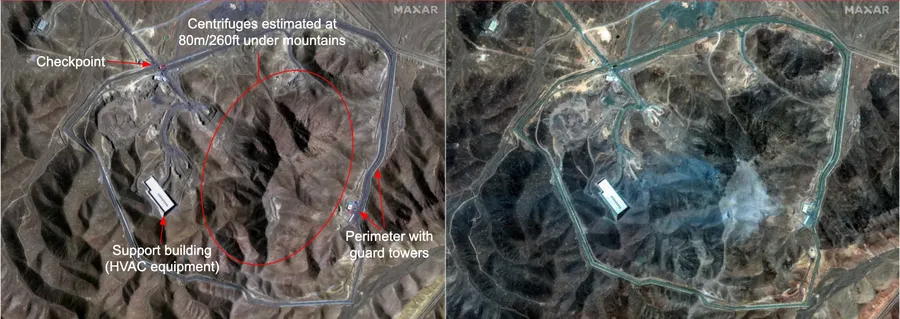
A combination picture shows satellite images over Fordow underground complex, before and after the U.S. struck the underground nuclear facility, near Qom, Iran. REUTERS
Despite repeated Israeli assertions that Iran has definitively restarted its nuclear weapons program, the U.S. intelligence community remains unconvinced of such a conclusion. In March, Director of National Intelligence Tulsi Gabbard explicitly stated that American agencies assess Iran suspended its nuclear weapons ambitions in 2003 and that Supreme Leader Khamenei had not re‑authorized such a program. Moreover, senior U.S. analysts argue that while Iran has substantially enriched uranium, accumulating more than 400 kg at nearly 60% purity, there is no evidence indicating a concerted effort to weaponize the material. They stress that building a functional bomb still requires significant additional steps, including warhead design and integration with delivery systems, capabilities that U.S. intelligence says Tehran has not formally pursued.
In contrast, Israeli Prime Minister Netanyahu and supporting military analysts interpret the same intelligence differently, claiming that Iran has moved "very close" to a bomb and is actively weaponizing its enriched uranium stockpile. This divergence in interpretation is emblematic of deeper strategic fault lines: Washington seeks calibrated assessments to inform diplomacy and avoid conflict escalation, while Israel focuses on worst‑case framings to justify preemptive military action and rally domestic resilience. Such contradictory threat perceptions, framed by each government’s political calculus and security doctrines, have tangible implications as policymakers weigh military intervention against diplomatic avenues going forward.
The Israeli government has explicitly framed its actions as a necessary measure to prevent the Islamic Republic from reaching nuclear breakout capability, citing a convergence of intelligence assessments indicating that Tehran was on the verge of enriching weapons-grade uranium at multiple hardened sites, including Fordow and Natanz. These operations are grounded in Israel’s long-standing military doctrine of strategic preemption, most notably exemplified in the 1981 strike on Iraq’s Osirak reactor and the 2007 attack on Syria’s Al-Kibar nuclear facility, actions taken unilaterally, and without international approval, to neutralize existential threats before they could fully materialize.
Israel and the U.S.’s legal and strategic rationale for the strike campaign against Iran rests on a claim of preemptive self-defense grounded in both historical precedent and dynamic threat assessment. Drawing comparisons to its 1981 airstrike on Iraq’s Osirak nuclear facility, Israeli officials have invoked the doctrine of anticipatory action, arguing that Iran had crossed critical enrichment thresholds, rendering its nuclear program no longer speculative but imminent. The justification hinges on classified intelligence assessments reportedly shared with U.S. and European counterparts, which indicated that Iran had accelerated centrifuge deployment and begun preparations for weaponization pathways previously undeclared. While Israel has not formally submitted these findings to international bodies, its leadership has characterized the intelligence as actionable and time-sensitive, leaving little margin for multilateral deliberation.
Intelligence, in this context, operates not only as the evidentiary foundation for Israel’s military action but also as a strategic instrument of statecraft. Israel has sought to shape both elite and public perceptions of the Iranian threat. This information campaign, while opaque in terms of sourcing and verification, has effectively framed Iran as a state on the cusp of nuclear breakout, with malign intent and a shrinking window for deterrence. The reliance on intelligence as both trigger and narrative architecture mirrors past Israeli doctrine, wherein secrecy, precision, and psychological priming precede kinetic engagement.
Yet the burden of credibility in intelligence-led warfare is high, particularly in a region marred by prior intelligence failures and disinformation campaigns. Unlike the Osirak strike, which occurred in an era of limited scrutiny and slower information flow, the current conflict unfolds in an environment saturated with real-time analysis, partisan interpretation, and algorithmically driven media ecosystems. Israel’s claims, while compelling to its allies, remain contested by a range of international actors who view the absence of transparent evidence and multilateral consensus as undermining the legitimacy of the operation. As a result, the war is being fought not only on physical terrain but also in the legal and epistemic domains, where truth and legitimacy are all subject to contestation.
From the standpoint of international law, Israel and the U.S.’s position occupies a legally contentious space, situated at the fault line between Article 51 of the UN Charter and customary norms of sovereignty. Proponents of the strike argue that the existential threat posed by a nuclear-capable Iran justifies unilateral defensive measures, especially given the apparent erosion of the Joint Comprehensive Plan of Action (JCPOA) and the International Atomic Energy Agency's findings that Iran was in breach of its obligations under the Nuclear Non-Proliferation Treaty. Critics, however, point to the absence of a clear, imminent armed attack by Iran and argue that preemptive force without Security Council authorization contravenes core principles of non-aggression. This interpretive divide underscores a broader legal ambiguity in the global security architecture, where normative rules often lag behind emerging threats and asymmetries of power.
Under American law, the president’s authority to launch a strike against Iran, absent congressional authorization, rests on a contested interpretation of executive war powers, particularly as framed by the 1973 War Powers Resolution and Article II of the U.S. Constitution. While the executive branch has long claimed that the president may order limited military action to protect national interests without prior approval from Congress, critics argue that such unilateral action stretches constitutional intent and undermines legislative war powers. The Trump administration justified previous strikes on Iranian targets, such as the 2020 killing of Qassem Soleimani, on the basis of both inherent self-defense powers and the 2002 Authorization for Use of Military Force (AUMF) against Iraq, an interpretation widely challenged as a distortion of congressional mandate. The ambiguity arises from decades of presidential precedent, during which successive administrations have expanded executive authority in the domain of foreign military engagement, often with post hoc rationalizations rather than clear statutory support. Consequently, any strike on Iran without explicit congressional support, while fraught, is likely illegal.
According to sources within the Israeli defense establishment as well as open source tracking, Israeli strikes have targeted a constellation of facilities central to Iran’s nuclear weapons infrastructure, as well as key Islamic Revolutionary Guard Corp (IRGC) command-and-control nodes. Satellite imagery and post-battle damage assessments indicate that Israeli fighter aircraft conducted precision strikes on underground bunkers, suspected centrifuge halls, and hardened radar-protected compounds. In conjunction with these kinetic operations, Israeli commando units and electronic warfare teams reportedly launched coordinated suppression missions to degrade Iranian air defense networks during the initial wave of attacks, further underscoring the multidomain character of this operation. The IDF has described these strikes as both "surgical" and "decisive," designed not merely to delay Iran's program but to permanently dismantle its capacity to weaponize fissile material.
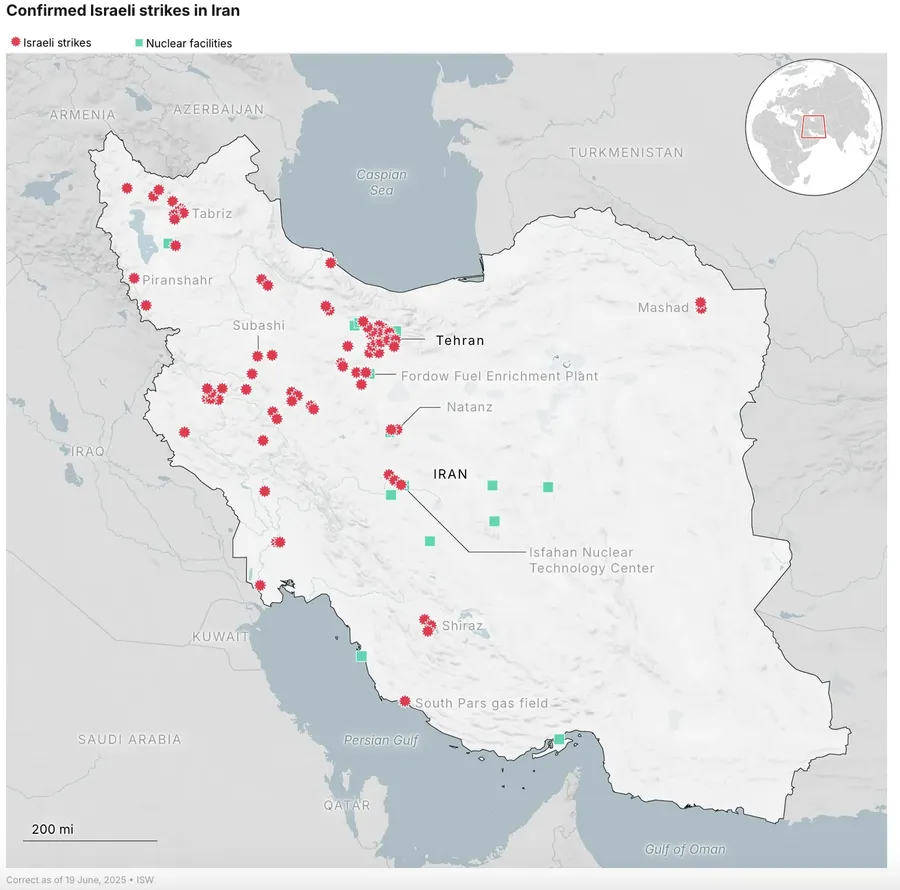
Map of Israeli strikes in Iran until June 19th - Source: The Daily Mail
Strategically, the operation appears calibrated not only to blunt Iran's nuclear timeline but also to signal Israeli resolve in an era of diminishing U.S. deterrence and increasing regional instability. By striking deep into Iranian territory, Israel is reaffirming its strategic autonomy and willingness to act unilaterally when core national interests, specifically the preservation of its nuclear monopoly, are perceived to be at risk. Simultaneously, the political messaging emerging from the Prime Minister’s office is calibrated for both domestic and international audiences: domestically, to project strength and deter political rivals; internationally, to frame the operation as a necessary act of self-defense under Article 51 of the U.N. Charter, despite the lack of multilateral endorsement. This dual-level signaling reveals the complex interplay between realpolitik, national security imperatives, and international norms that now define Israel’s strategic posture vis-à-vis the Iranian threat.
Furthermore, the scope and ambition of Israel’s current military campaign suggest a long-term reconsideration of its deterrence doctrine, expanding beyond reactive defense to encompass sustained degradation of adversarial infrastructure deep within hostile territory. By targeting not only known enrichment facilities but also missile production sites, IRGC logistical hubs, and research installations suspected of dual-use capabilities, the IDF is executing a broad-spectrum offensive intended to collapse Iran’s integrated warfighting and strategic development architecture. This approach reflects a recognition within Israeli strategic circles that the Iranian threat is not merely a nuclear one, but a systemic challenge involving conventional force projection, regional proxy warfare, and asymmetric retaliation. The breadth of the strikes, coordinated with real-time intelligence, deep surveillance assets, and advanced electronic warfare platforms, also highlights the operational maturity of Israeli strategic planning, which now embraces simultaneity and multidimensional pressure as core tenets of its regional security paradigm.
In the wake of Israel’s deep-penetration strikes against key Iranian nuclear and military infrastructure, the Islamic Republic has responded with forceful barrages of ballistic missile and drone attacks. Tehran’s decision to retaliate openly, rather than through proxies or cyber channels, represents a significant escalation in both strategic signaling and doctrinal posture. No longer confined to asymmetric reprisal or plausible deniability, Iran is asserting its capacity to retaliate against a regional nuclear adversary with direct, state-level force.
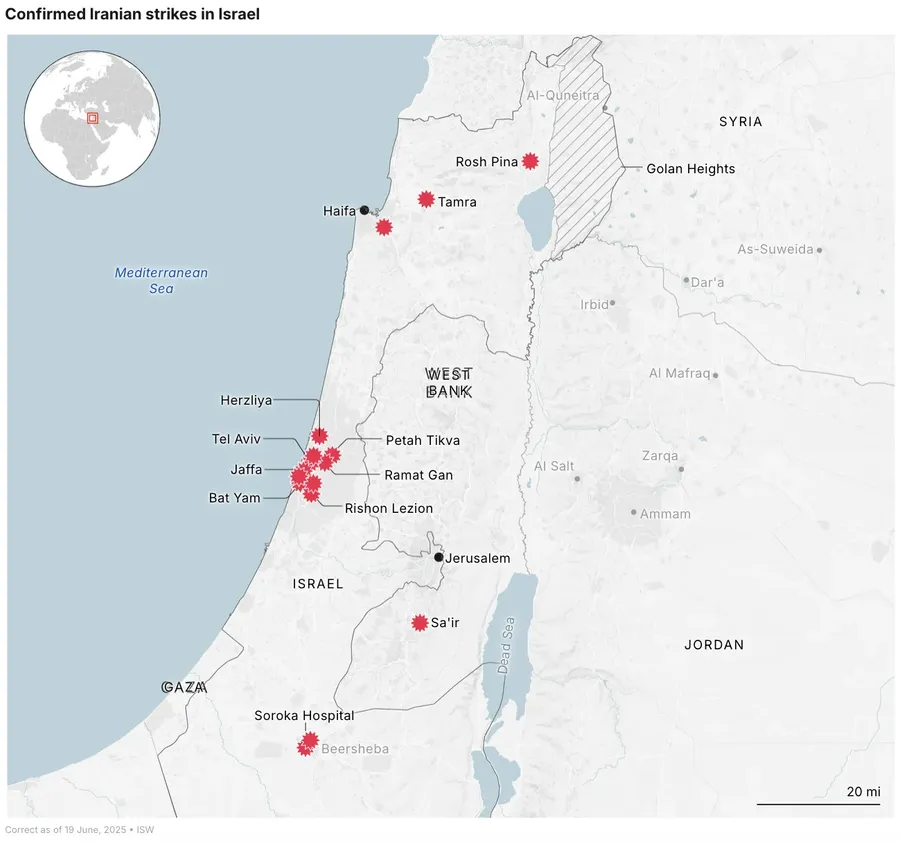
Map of strikes in Israel up until June 19th - Source: The Daily Mail
The missile strikes have seemingly attempted to target a mixture of military installations, including air bases, logistics hubs, radar sites, and civilian infrastructure within Israeli urban centers. This bifurcated targeting strategy appears to serve both tactical and psychological objectives. On one hand, it aims to degrade Israel’s operational capacity to launch sustained aerial campaigns; on the other, it seeks to induce public anxiety, political pressure, and symbolic parity by demonstrating that Iranian missile systems can penetrate Israel’s multi-layered missile defense architecture. While the Arrow and David’s Sling systems have reportedly intercepted a substantial portion of incoming projectiles, the saturation effect and adaptive trajectory programming of Iranian ordnance have exposed vulnerabilities in Israeli air defense doctrine.
However, Iran’s missile salvos against Israel have starkly illuminated the intrinsic limitations of its strategic bombardment doctrine, which hinges on saturation rather than precision. According to some observers of the October 2024 strikes, Iran purportedly targeted Israeli military and intelligence sites, yet hit rates remained dismally low, underscoring a mismatch between ambition and technical execution. The Institute for International Strategic Studies further critiques Tehran’s reliance on medium-range ballistic missiles, noting that during the 2024 campaign, these systems “demonstrated limited accuracy, restricting their value in counterforce roles” which may explain Iran’s possible decision to switch to counter-value targeting. Consequently, despite the volume of weapons launched, the cumulative strategic effect is diluted by systemic inaccuracy, leaving Iran’s coercive intent undermined by palpable imprecision.
Tehran’s information apparatus has simultaneously weaponized the narrative of resistance, positioning the strikes as both defensive necessity and moral obligation. Statements from senior IRGC commanders, amplified by state-aligned media outlets characterize the missile operations as calculated punishment and a step toward strategic deterrence equilibrium. This rhetorical framing is not merely propagandistic; it reflects Iran’s larger ambition to redefine the rules of regional engagement. By abandoning proxy intermediaries in favor of direct sovereign action, Iran appears to be claiming a kind of strategic adulthood, staking its place as a peer competitor to Israel, rather than a subordinate actor reliant on asymmetry.
Still, the risks associated with this posture are profound. Iran’s cities, while equipped with some level of air defense, remain highly vulnerable to retaliatory air strikes, particularly on command infrastructure, industrial zones, and power grids. Moreover, Tehran’s decision to escalate through overt ballistic missile use has activated a wider set of regional alarm bells, particularly in Gulf states. The intersection of technological capability and political will in Tehran now places the Islamic Republic on the threshold of conventional warfare escalation, a domain in which it has little operational experience against a peer adversary like Israel. As Iran asserts its deterrent power through missiles rather than diplomacy, the conflict narrative inches perilously closer to a mutually reinforcing cycle of provocation and reprisal with uncertain thresholds.
The human cost of the Israel-Iran conflict is rapidly accumulating on both sides, underscoring the multidimensional nature of contemporary warfare. In Israel, waves of Iranian ballistic missile attacks have seemingly stretched even the country’s sophisticated layered air defense systems, with David’s Sling and Arrow intercepting a significant, but not exhaustive, volume of incoming fire. Despite these technological safeguards, strikes on urban centers such as Tel Aviv, Haifa, and Ashdod have resulted in civilian casualties, infrastructural damage, and widespread psychological trauma. Hospitals have activated mass casualty protocols, while schools and public services across central Israel remain shuttered indefinitely. The specter of a prolonged air campaign has introduced a new mode of public vulnerability not witnessed since the Gulf War.
On the Iranian side, Israeli airstrikes have targeted high-value military and infrastructural sites with precision, leveraging satellite intelligence and real-time signals intercepts to cripple air defense batteries, IRGC command nodes, and suspected nuclear enrichment facilities. However, the relentless Israeli air campaign, which has pulverized crucial military and nuclear infrastructure in Tehran, has also precipitated mass displacement, critically impaired essential services, and induced pervasive psychological distress, particularly among those trapped without reliable shelter or communication amid intermittent internet blackouts. Even as the strikes claim dozens of lives and inflict widespread structural damage, many Iranian civilians, though vocally critical of both their government and external intervention, are left immobilized by fear, logistical obstacles, and fracturing social cohesion, underscoring the devastating human toll of urban bombardment in modern warfare.
Strategically, the mutual infliction of damage marks a departure from previous cycles of retaliation and escalation, wherein both actors operated largely in the dark. This conflict, however, has pierced the veil of deniability, and in doing so has fundamentally restructured the calculus of deterrence. The Israeli air campaign, measured and surgical though it may be, is premised on the assumption that strategic pain will induce Iranian restraint; yet Iran’s targeting of Israeli civilian areas calls this assumption into question. More perilously, both nations now face the destabilizing feedback loop of demonstrating resolve while avoiding existential miscalculation. If neither side is willing to absorb damage without escalating in turn, the conflict risks evolving into a prolonged war of attrition with no clear threshold for de-escalation.
American involvement, long discussed in speculative terms, became a matter of fact when U.S. bombers struck Iran’s nuclear facilities. Per statements from the White House, the strike was coordinated in conjunction with Israeli operations and carried out with the express aim of crippling Iran’s nuclear program infrastructure. The attack constitutes the first time in decades that the United States has conducted a kinetic operation on sovereign Iranian soil, a move that signals both the scale of Washington’s commitment and the seriousness with which it regards Tehran’s nuclear trajectory. This escalation, however, risks broadening the conflict into a region-wide conflagration.
The United States now finds itself navigating a complex and precarious position in the unfolding Israel-Iran conflict, oscillating between its longstanding alliance with Israel, its desire to prevent a broader regional conflagration, and its imperative to manage great-power rivalries. Publicly, the White House has characterized its support for Israel as unshakeable, emphasizing the strategic necessity of preventing Iran’s nuclear breakout. Behind closed doors, however, some senior administration officials reportedly harbor concerns about escalation spiraling beyond control, particularly if Israeli and American strikes force Iran to activate its proxy network in Yemen or Iraq or attempt to close maritime chokepoints such as the Strait of Hormuz. U.S. intelligence assistance, cyber coordination, and mid-air refueling capabilities suggest a level of embeddedness in Israeli operations that approaches de facto co-belligerency.
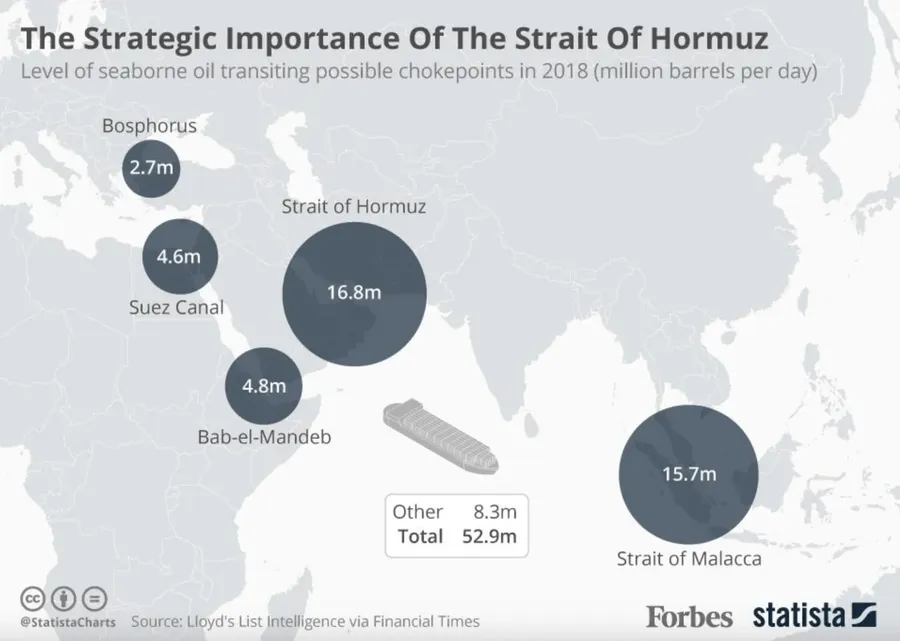
This posture reflects both tactical calculation and political constraint. On the one hand, U.S. officials recognize that strategic inaction could embolden Iran, weaken Israeli deterrence, and fracture existing regional security architectures, especially those forged under the Abraham Accords. On the other, the prospect of being drawn into another protracted Middle Eastern war sits uneasily with both the public and many members of Congress, some of whom have questioned the wisdom of entrusting a conflict with nuclear overtones to bilateral escalation dynamics. Congressional briefings have revealed stark divisions, with hawkish voices calling for punitive strikes against Iranian missile factories and more dovish factions advocating for multilateral diplomacy via the United Nations or European interlocutors. Thus, the administration’s balancing act is not merely operational but existential: it must simultaneously project strength, manage escalation, and safeguard American strategic interests without escalating a war it cannot contain.
Notwithstanding, the Trump administration’s expedition into Iranian airspace has provoked a crescendo of warnings from Tehran. Iranian Foreign Minister Abbas Araghchi ominously warned that every American military site and citizen would henceforth be deemed lawful targets, a message reiterated in official state media across varied channels. The Pentagon’s defensive posture, evidenced by the deployment of additional aircraft carriers, destroyers, F‑16s stationed in Saudi Arabia, missile-defense systems at al‑Udeid and al‑Asad airbases, and the evacuation of embassy dependents, starkly underscores an acute awareness of the looming threat. Although Iran’s long-range missile cache was degraded by Israeli strikes, its arsenal of short-range rockets and Iraqi proxies remains potent enough to inflict substantial damage on forward-deployed U.S. personnel and infrastructure.
Iran stands at a crossroad of strategic choices: it can initiate a limited missile-and-drone barrage on American bases, orchestrate proxy assaults or disrupt global energy flows by mining or threatening the Strait of Hormuz, each option laden with its own strategic payoff and peril. Historically, Tehran has calibrated its response: after the 2020 killing of Qassem Soleimani, Iran struck U.S. bases in Iraq with ballistic missiles, causing hundreds of traumatic brain injuries but stopping short of inflicting fatalities, a measured strike aimed at psychological impact without triggering full-scale war. Yet the consensus among defense experts is that any Iranian assault, whether kinetic or via malign cyberattacks, would likely yield a disproportionately aggressive American counter-response, prompting regional escalation or even enlargement of the conflict into theater-wide warfare.
Destabilization of global energy markets adds another pernicious dimension. Iran’s capacity to lash out in the Strait of Hormuz risks precipitating a spike in oil prices, a potential crucible of economic vulnerability for the U.S. and its allies, but it would also inflict significant collateral economic harm upon Iran, inviting sweeping multilateral reprisals. Concurrently, the United States has shored up air defense, naval presence, and forward deployments not merely to blunt an imminent strike, but to project deterrence signaling that any Iranian action against American assets would be met with decisive force. As such, although material damage to U.S. outposts remains likely in the near term, the fundamental question is whether Tehran retries calibrated reprisal to assert resistance or refrains in deference to the gravest threat it now faces, an inexorable American rollback against its ambitions in the region.
For Iran, the perception of U.S. complicity in Israeli aggression functions as both a mobilizing narrative and a strategic redline. Iranian state media has repeatedly invoked the specter of “Anglo-Zionist aggression,” conflating U.S. logistical support with moral culpability. High-ranking IRGC officials have explicitly threatened retaliation against American regional assets, including military installations in Iraq, Syria, and the Gulf states, should the U.S. cross what Tehran defines as the threshold of active participation. These warnings are not merely rhetorical. In April 2025, prior to the outbreak of open hostilities, Iranian-backed militias in Iraq increased drone activity near U.S. bases, suggesting a well-prepared escalation ladder. The risk calculus, then, hinges on whether Iran believes U.S. involvement has already reached that threshold, and whether Washington is prepared to absorb and respond to retaliatory strikes without opening an irreversible regional front.
In this sense, the U.S. is less a detached observer and more a latent protagonist, enmeshed in the conflict’s escalation dynamics whether it wishes to be or not. Its military footprint, intelligence-sharing arrangements, and declarative posture bind it to Israel’s strategic trajectory, while also exposing American interests to asymmetric retaliation across the region. The Trump administration’s ability to simultaneously deter Iranian adventurism, restrain Israeli overreach, and assure Arab partners of its stability commitment constitutes a near-impossible trifecta. Should any of these elements falter, the conflict risks metastasizing beyond its current parameters, pulling the U.S. into a war not by design but by gravitational inevitability. In this light, America’s role is not simply to support or restrain, it is to shape the very logic of escalation itself.
While Israel and Iran exchange direct military blows, the Arab states find themselves caught in a precarious balancing act, between pragmatic geopolitical alignments and deep-seated historical sensitivities. The Abraham Accords, once hailed as a transformative breakthrough in Arab-Israeli normalization, now confront their most formidable stress test since inception. States such as the United Arab Emirates and Bahrain, while officially aligned with Israel in economic and technological domains, have issued cautious statements that reflect a reluctance to be seen as complicit in what is widely viewed in Arab public opinion as an aggressive escalation by Tel Aviv. Meanwhile, Saudi Arabia’s posture remains deliberately opaque, signaling both an unwillingness to fracture its tentative outreach to Israel and an acute awareness of domestic and regional backlash were it to appear overly sympathetic to Israeli strategic objectives. This diplomatic hedging underscores the structural fragility of regional alliances built more on shared enmity toward Iran than on any resolved ideological or territorial concord with Israel.
Concurrently, Iran’s axis of resistance, comprising Hezbollah, Hamas and numerous Shi’a militias across Iraq and Yemen, has responded with a silence that is as notable as it is revealing. The absence of a coordinated, multi-front eruption from Iran’s regional network suggests either an unwillingness to intervene, or more likely an inability. Nearly two years of war have likely dented Hezbollah’s stockpiles of rockets and missiles while previous Israeli strikes have greatly weakened the group’s organizational structure. Hamas on the other hand has been rendered nearly completely impotent, confined to underground tunnels in Gaza.
The psychological and strategic implications of Iran obtaining a nuclear weapon would be profound, not only for Israel but for the broader Middle East. For Israel, a nuclear-armed Iran represents an existential threat that fundamentally undermines the doctrine of unilateral deterrence upon which much of its defense policy has historically depended. Regionally, a successful Iranian nuclear test, or even a confirmed weapons-capable threshold, could trigger a destabilizing cascade of proliferation: Saudi Arabia, Turkey, and Egypt have all alluded to revisiting their nuclear postures in the event of Iranian success. Such a development would unravel decades of nonproliferation diplomacy and introduce new dimensions of instability into an already volatile strategic landscape. Moreover, it would embolden Tehran's regional proxy network, fundamentally altering the deterrence calculus for the U.S., NATO, and Gulf Cooperation Council (GCC) states.
Adding to the gravity of the moment are previously conducted wargames, such as the Bulletin of the Atomic Scientists’ 2024 simulation, which forecasted that a conventional war between Israel and Iran could escalate to nuclear use within mere days under certain strategic conditions. These simulations underscore how fragile the ladder of escalation truly is when both adversaries perceive existential stakes and operate within compressed decision cycles. With Iran’s command-and-control potentially decentralized under duress and Israel operating under a doctrine of preemptive clarity, the risk of miscalculation or overreaction is not merely theoretical but structurally embedded. Furthermore, Israel’s longstanding opacity regarding its own nuclear arsenal complicates international efforts to impose symmetry or mutual restraint, deepening the fog of deterrence rather than dispelling it.
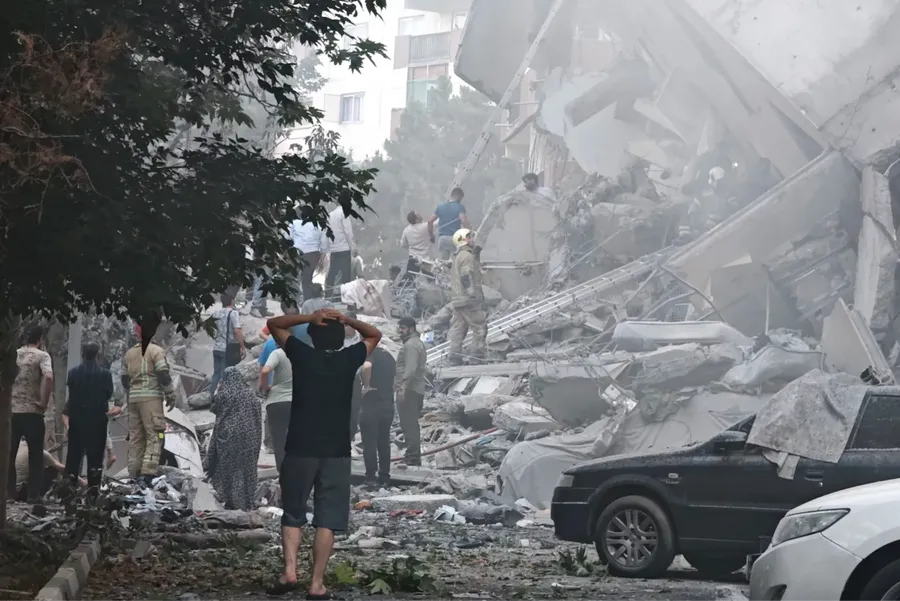
People look over damage to buildings in Nobonyad Square following Israeli airstrikes on June 13, 2025 in Tehran, Iran (Majid Saeedi/Getty Images Europe)
The present conflict thus operates in the shadow of nuclear ambiguity, where the weapon in question need not be detonated to shape behavior, it need only be believed to exist. Iran’s potential acquisition of a nuclear weapon would represent not just a material escalation, but a profound symbolic inversion of the regional power balance. In response, the strategic doctrine of containment, so often invoked during the Cold War, may prove inadequate against an ideologically driven state with both transnational proxies and an active missile program. Consequently, the implications of Iran's nuclear trajectory cannot be confined to the Israeli-Iranian dyad; they radiate outward into every corridor of global security architecture, demanding a recalibration not only of regional deterrence theory but of the credibility and adaptability of the global nonproliferation regime itself.
As the Israel-Iran conflict accelerates into its second week, the diplomatic vacuum surrounding it grows more conspicuous and ominous. The United Nations Security Council remains paralyzed, mired in geopolitical fragmentation, with vetoes and abstentions stalling substantive resolutions. European capitals, while condemning Iran’s missile barrages and urging restraint from Israel, appear strategically impotent, reduced to issuing statements devoid of coercive leverage. The United States, though ostensibly seeking de-escalation, is entangled in a contradictory posture: providing operational intelligence to Israel while simultaneously signaling openness to mediation. Russia and China, for their part, have opportunistically leveraged the crisis to critique American unilateralism, while offering vague support to Iran under the guise of defending regional sovereignty. In effect, the prevailing diplomatic climate resembles an echo chamber of managed concern, loud, repetitive, and ineffectual.
Endgame scenarios remain speculative, but none are promising. A prolonged war of attrition risks dragging the region into a broader conflagration, with non-state actors like Hezbollah and Iranian-backed militias in Iraq potentially mobilizing in response to Israeli or American escalations. Conversely, a negotiated ceasefire without meaningful guarantees on nuclear constraints or missile deactivation would be interpreted by both parties as a tactical pause rather than strategic resolution, merely resetting the countdown to the next kinetic phase. The absence of a viable conflict termination framework, combined with maximalist objectives on both sides, suggests that traditional diplomacy is unlikely to suffice. If the war does not culminate in outright regime collapse, nuclear breakout, or the reversal of Iran’s nuclear weapon ambitions, it may instead ossify into a new regional equilibrium, violent, fragile, and governed by fear rather than formal agreements.
The eruption of direct military hostilities between the U.S., Israel and Iran signals a profound transformation in the architecture of Middle Eastern security, displacing decades of covert confrontation with overt and sustained armed conflict. What had previously been a theater of deniable cyberattacks, proxy wars, and intelligence operations has metastasized into an escalatory cycle of missile strikes and preemptive aerial campaigns. This transition marks not only the collapse of strategic ambiguity but the erosion of the diplomatic buffer zones that once kept Tehran and Jerusalem from crossing the threshold into full-scale war. The implications reverberate far beyond the battlefield, challenging the foundations of regional deterrence and exposing the limitations of existing multilateral frameworks for conflict containment.
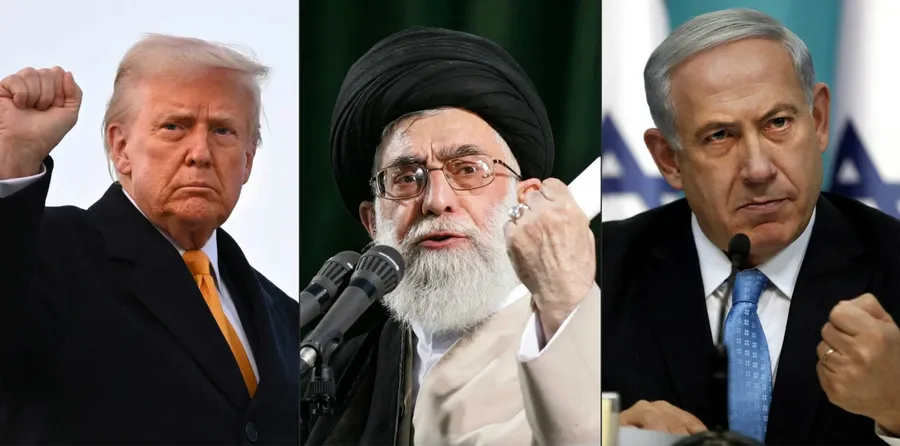
(Source: International Crisis Group)
The unfolding confrontation between the United States and Iran raises profound questions about the limits of military escalation and the elusive search for a sustainable strategic equilibrium in the Middle East. By striking Iranian nuclear facilities, an act with clear kinetic consequences but opaque long-term objectives, Washington may have committed itself to a trajectory of confrontation without a credible exit strategy. While proponents of deterrence argue that such action forestalls Iranian breakout capabilities, the fundamental risk remains that Iran will interpret these attacks not as a red line enforcement but as an invitation to escalate asymmetrically across the region. In such a context, the logic of containment morphs into the logic of perpetual reaction, with each retaliatory gesture drawing the United States deeper into a conflict whose boundaries and aims are increasingly undefined.
Moreover, the precedent set by this intervention poses a structural problem for the broader international system. If the U.S. can justify unilateral military action against a sovereign state on the basis of opaque intelligence assessments and loosely interpreted self-defense doctrine, it weakens the norms of non-aggression that underpin global diplomatic architecture. Iran’s nuclear ambitions, while deeply concerning, exist within a broader framework of strategic deterrence and regional posturing that has, until now, been managed primarily through indirect means. By abandoning the slow and often frustrating work of diplomacy in favor of targeted strikes, the United States signals to both allies and adversaries that the use of force remains not only thinkable but preferable. This recalibration of strategic priorities risks undermining the very international stability it claims to defend.
The central question confronting policymakers is not simply whether the strikes will “work,” but what constitutes success in a conflict that defies resolution through conventional means. If Iran retaliates and the cycle of provocation and reprisal deepens, will Washington be prepared for a prolonged confrontation, or will it retreat into strategic ambiguity once the initial show of force has run its course? The administration’s refusal to clearly define its objectives, regime containment, nuclear deterrence, regional rebalancing, invites the very instability it seeks to avoid. As with previous American interventions in the region, the danger lies not in the absence of military capability, but in the absence of strategic clarity. Without a clearly articulated endgame, the line between limited engagement and open-ended war becomes perilously thin.